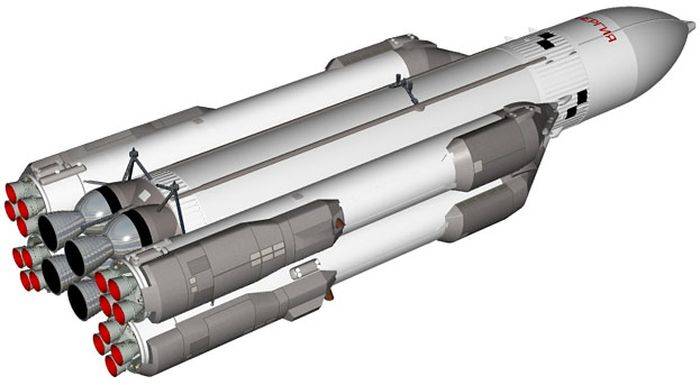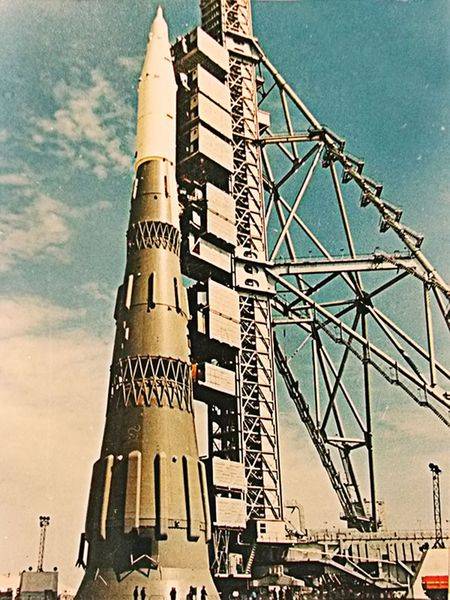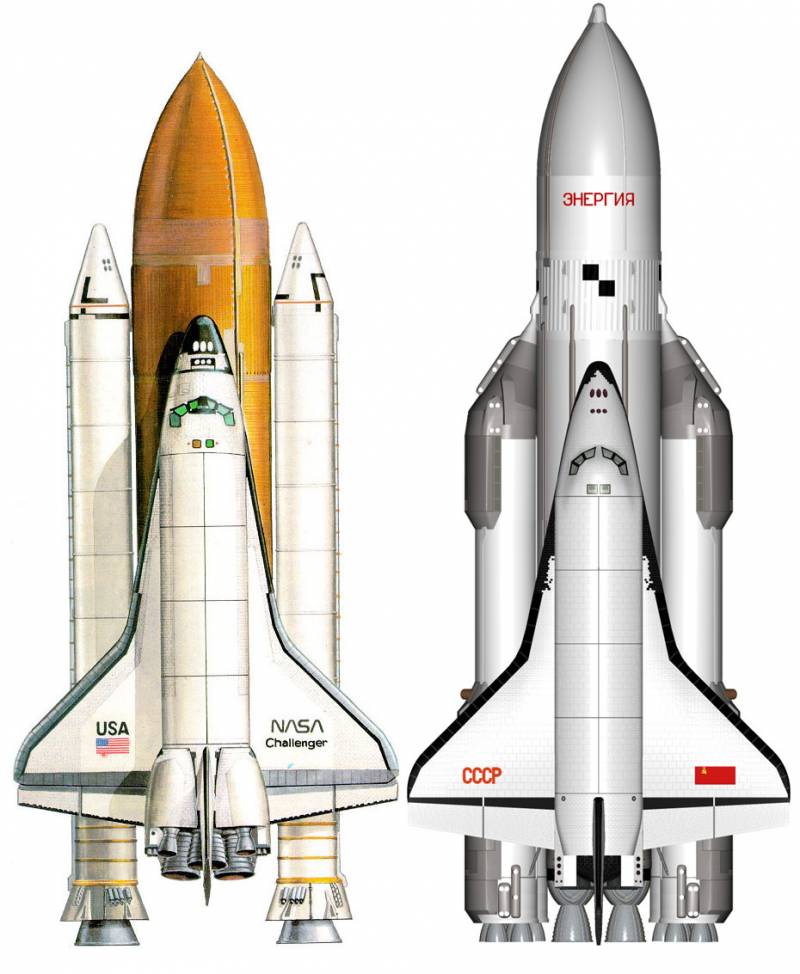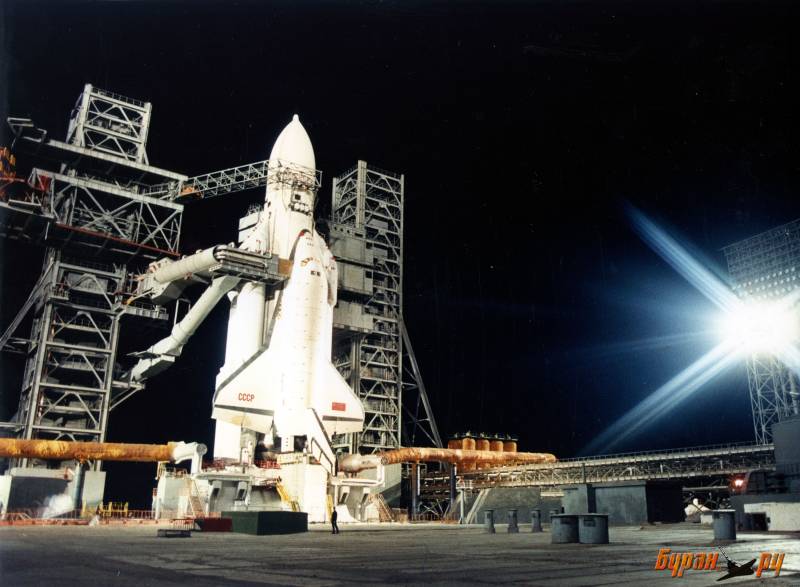Reincarnation of the Soviet project. In Russia, thinking about the revival of a giant rocket
The fact that Roskosmos will show the layout of the Russian super-heavy rocket has become known from public procurement materials published on the website. The documentation, which concerns the Roscosmos exposition at the Army-2018 forum, states that the Rocket and Space Corporation (RSC) Energia will present a model of a 5,5 rocket with a meter height of one to twenty. Also within the framework of the forum, RSC Energia is going to present a mock-up of a new Russian Soyuz-5 rocket, from the first few stages of which it is planned to create the first stage of a super-heavy rocket. Another prototype of the Soyuz is planning to present the Progress Rocket and Space Center (RCC) from Samara. It is already known that Energia is developing the Soyuz-5 rocket, and it will be assembled in Samara at RCC facilities. The Army-2018 Forum will be held from 21 to 26 in August in the Patriot park near Moscow.
There is also information that the aerospace committee of the Ministry of Defense and the aerospace industry of the Republic of Kazakhstan (Kazkosmos) will take part in the development of the super-heavy Russian rocket. This August 1 reported RIA "News"With reference to its sources in the Kazakh specialized ministries. It is reported that the project to create a super-heavy rocket is designated in the concept of further cooperation between the two states at the Baikonur cosmodrome as the main one. The two countries also intend to jointly develop an ultra-light rocket designed to launch small satellites, as well as to launch production of components for rocket technology at Baikonur.
Earlier in the beginning of 2018, President of the Russian Federation Vladimir Putin signed a decree on the creation of an extra-heavy rocket. Then it became known that the RSC Energia was appointed the main developer of the new rocket. By the end of 2019, the draft design of the new rocket must be completed, and its first launch was then assigned to 2028. A new super heavy class rocket is planned to be used, in particular, for flights to the Moon and Mars. It is worth noting that the development of the most powerful rocket at the moment stories Our country was also engaged in the engineers of "Energy".
The rocket, developed by the Scientific and Production Association "Energy" almost 30 years ago, made only two flights. The first took place on 15 in May of 1987, it was a flight with an experimental load. The second flight was performed on 15 November, 1988, as part of the Buran reusable transport space system. Since almost the only target launch of the rocket, almost exactly three decades have passed. Neither before nor after the domestic space industry did not create such a powerful rocket that would compete with the Soviet H-1 and American Saturn-5.
The Soviet super-heavy booster Energia was part of the Energia-Buran reusable transport space system (MTKS), but unlike the American-made MTKS Space Shuttle it could be used autonomously from the space shuttle to deliver cargo into space with large mass and dimensions. Cargo could be delivered not only to the orbit of the Earth, but also to the Moon, as well as to the planets of the Solar System. Also, Energia could be used for manned flights, its development was associated with Soviet plans for the widespread development of industrial and military space. The collapse of the Soviet Union put an end to this ambitious and very expensive space program.

After 30 years, there is a chance that now Russia, albeit in cooperation with other countries, will be able to develop a new super-heavy rocket, using the Soviet groundwork for the Energiya booster rocket to do this, the new rocket could become the cornerstone for the implementation of all future spacecraft. ambitions of our country. While the Buran reusable orbital spacecraft will remain only the heritage of history, the Energia launch vehicle in the reincarnation of the 21st century can become the basis for a new domestic super-heavy class rocket. Especially when you consider that “Energy” was in all respects a unique rocket. She became the first in the Soviet Union to use cryogenic fuel (hydrogen) at the march stage, and the most powerful of the missiles ever created in the USSR. This can be assessed quite easily - Energia ensured the launch into space of spacecraft weighing five times more than the Proton rocket currently in use in Russia and three times more than the American Space Shuttle system.
It is worth noting that the super-heavy class of rockets begins with a mark in 50 or 60 tons of cargo that can be delivered to a low near-earth orbit (for higher orbits or for interplanetary flights, this figure decreases proportionally). The problem is that for 60 years of space exploration for such rockets there was no use, except for launches of inhabited spaceships to the Moon, as well as launching space shuttle returned to near-earth orbit. These huge carrier rockets turned out to be too complex, too expensive to manufacture and operate, and too inflexible for more practical use, including for business, scientific and military launches of satellite launches actively developing today.
Despite all this, mankind has not refused such missiles, but already a new generation. Above the rockets, designed to fly astronauts beyond the Earth’s orbit, they work at NASA. Here they create a giant Space Launch System. A new heavy rocket Falcon Heavy of a private American company SpaceX made its impressive first flight at the beginning of 2018, which was also presented as an excellent marketing move. China also has its own projects on the creation of super-heavy rockets; it is expected that Chinese missiles will compete with the legendary Saturn-5 rocket.

In the Soviet Union during the Cold War, the idea of creating their own super-heavy rocket was addressed twice. The first project is the X-NUMX-meter H-100 rocket for the lunar program, which was supposed to compete with the American Apollo program. In 1, after four unsuccessful launches of the H-1974 rocket, it was decided to abandon further work on the project. As a result, the USSR took another 1 years of work in order to create an Energia launch vehicle, which eventually made two successful flights. This 10-meter rocket was recognized by many experts as the most powerful and modern rocket of its time.
However, after the collapse of the Soviet Union in 1991, this rocket was placed in hangars at the Baikonur cosmodrome, where it safely rusted for many years. Numerous workers of the domestic space industry were forced to forget about its existence, and the key technologies - supercomplex hydrogen engines - in the industry turned out to be an unclaimed product of high technologies. For almost two decades, when the Russian Federation struggled to establish itself and find its own place in the world, there could be no question of reviving the Energia rocket. However, the rise in oil prices in the 2000s and the restoration of the Russian economy allowed the country to strengthen its position in the world. That is why the emergence of a super-heavy rocket of a new generation seems to be quite an attractive chance for the country, which will help to return to Russia the status quo in the space sphere.
In the proposed version, the reincarnation of the Energia rocket will be able to deliver up to 20 tons of cargo into the Moon's orbit or lift tons of payload to a low earth orbit up to 80. While the first version of Energia could take the space shuttle attached to it from the side, the new version will be designed to bring the payload to the trajectories leading to the Moon in the nose cargo compartment-cone. Having received Kremlin approval for work, Roskosmos, already in April of 2018, signed a contract with rocket technology manufacturers who must submit a draft of a new Russian super-heavy rocket before the end of 2019 of the year. At the same time, the competition of the new “Energy” at the preliminary stage consists of two lighter and smaller in size missiles.
In the event that the concept of "Energy" really wins, in Russia it will be necessary to build the RD-0120 oxygen space engines again. Three of these engines will accelerate the main compartment of the new 7,7 diameter rocket meter (the same as the Soviet "Energy"). And the four RD-171 (outboard accelerators of the first stage, working on kerosene and inherited directly from Energia) will help the rocket during the first two minutes of its flight. With certainty, we can only say that the new super-heavy Russian rocket is at the very beginning of the design process, and there is not enough concrete about this project. It is possible that there will be more information for reflection when the mockup of a super-heavy class rocket will be presented to the general public at the end of August at the Army-2018 forum.
Information sources:
https://inosmi.ru/science/20180727/242840118.html
https://ria.ru/space/20180801/1525746959.html
https://russian.rt.com/inotv/2018-02-10/Popular-Mechanics-Rossiya-razrabativaet-sobstvennuyu
https://mir24.tv/news/16316388/kazahstan-i-rossiya-vmeste-postroyat-sverhtyazheluyu-raketu


Information